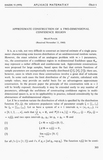Article
Full entry |
 PDF
(0.7 MB)
Feedback
PDF
(0.7 MB)
Feedback
 PDF
(0.7 MB)
Feedback
PDF
(0.7 MB)
Feedback
Summary:
If a sufficiently large random sample is taken from a population with known distribution, depending upon a couple $\zeta$ of parameters, so that Pearson $\chi^2$ criterion is applicable to test the agreement between the observed and the expected sample class frequencies, and if the $\chi^2$ statistic is considered to be a random function defined on the space of all admisible $\zeta$ values, then the region in on which $\chi^2$ is less than its $100\alpha$ per cent critical value, constitutes an approximately $100(1-\alpha)$ per cent level confidence region for the true population value $\zeta_0$ of $\zeta$. Under certain general conditions this region always exists and lies within a closed curve the graphic construction of which is not very difficult if the expected sample class frequencies in a sufficiently large area in , surrounding the maximum likelihood or the $\chi^2$ minimum estimate of $\zeta_0$, are known.
References:
[1] Bateman H. A. Erdélyi: Higher transcendental functions. vol. 1. McGraw-Hill, New York- Toronto-London, 1953.
[2] Таблицы логарифмической производной гамма-функции и ее производных в комплексной области. Вычислительный центр AHCCCP, Москва, 1965. Zbl 1099.01519
[3] Wilks S. S.: Shortest average confidence intervals for large samples. Ann. Math. Stat. 9, 166-175, 1938. DOI 10.1214/aoms/1177732308
[4] Wilks S. S.: Optimum fiducial regions for simultaneous estimation of several population parameters from large samples. (Abstract.) Ann. Math. Stat. 10, 85-86, 1939.
[5] Wilks S. S. J. F. Daly: An optimum property of confidence regions associated with the likelihood function. Ann. Math. Stat. 10, 225 - 235, 1939. DOI 10.1214/aoms/1177732181 | MR 0000386

